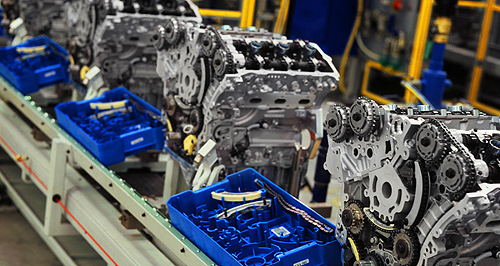Make / Model Search
News - HoldenHolden plant gets a Chinese burnFighting chance: The future of GM Holden’s Port Melbourne V6 engine plant is the subject of talks between GM and Australian governments. Beijing’s decision to favour Chinese fleet cars adds to Holden engine plant struggle16 Jan 2013 A CHINESE government decision to promote its indigenous automotive industry at the expense of overseas manufacturers has helped to throw a shadow over the future of GM Holden’s engine plant Australia. Beijing’s move to buy government fleet vehicles only from manufacturers fully owned by Chinese interests from 2012 cost Holden 15,000 V6 engine exports, or about 15 per cent of its total production of about 100,000 units a year. The engines are fitted to a popular Buick minivan made and sold in China by SAIC-General Motors joint-venture operation Shanghai-GM, which now does not qualify for government sales because of GM’s involvement. This put a major hole in one of Holden’s biggest export markets, although it still sends engines to China for vehicles bought by private customers. It also brings into sharp relief how government policies can affect the fortunes of their local car manufacturing and their rivals in a tough international environment.  Left: Holden's government and corporate affairs director Matt Hobbs. Left: Holden's government and corporate affairs director Matt Hobbs.Falling local sales of the Australian-built Commodore and derivatives such as the Holden Ute and Caprice – partly because of drooping government fleet sales in Australia – have also impacted the 10-year-old factory, along with the demise of export customer Saab and the struggles of GM’s European subsidiary Opel, whose Insignia OPC uses Holden power. The Port Melbourne plant, which shed a number of jobs through voluntary redundancies last year after the Chinese blow, is now the subject of high-level talks between Holden and all sides of government in Australia – state and federal – to see what can be made of the factory and its 300 jobs beyond 2016. Although Holden is not specifically saying what it wants to do with the plant, it has not ruled out a Toyota-style rebuild to make more-popular four-cylinder engines there from 2017. However, GM Holden government and corporate affairs director Matt Hobbs told GoAuto that a number of hoops need to be jumped through before Holden can decide if there is a future for the plant next to the company’s Australian headquarters. “There are a number of variables out there – what the dollar is going to be in another year or two’s time, what demand for Gen 1 V6 is going to be beyond 2016, what the footprints are for four-cylinder plants around the world – and those decisions are slowly being made,” he said. “We have got a bit of time. I would not want to put an exact timeframe on it.” Mr Hobbs and his Holden boss, chairman and managing director Mike Devereux, have both made it clear that the plant will not continue without government co-investment in a rebuild. “All around the world, whether it is the United States, the UK, Thailand, China, Japan – anywhere there is auto manufacturing – there is government policy that supports it, and if we don’t have long-term competitive and stable policies, then we won’t be able to do engine plant and we won’t be able to do cars,” Mr Hobbs said. He said Holden was in talks with all political parties, not just Labor and Liberal. “We don’t have a formal proposal before any government, but we have had discussions and it is something we will continue to do,” he said. Although the Labor Party has spelled out its assistance policy for the local automotive industry, the Coalition is yet to commit to its platform on the subject ahead of this year’s federal election. The $400 million engine plant – operated by Holden Vehicle Operations, along with the Elizabeth car manufacturing plant in South Australia – opened in 2003 as one of two plants in the world to build GM’s Global V6. About half the engines have been used for Holden’s own Australian-made cars, while the remainder have been shipped overseas to GM manufacturing plants in South Korea, China, Thailand and Europe. Versions of the engine were also exported to Saab and Alfa Romeo, as well as GM’s Mexican plant for the Cadillac SRX SUV, but all of these contracts have been discontinued. Holden’s use for the V6 is expected to end with the VF Commodore that is set to be launched into showrooms in about June this year. A new export version of the Commodore, the Chevrolet SS Performance, will provide a short-term shot in the arm for Holden manufacturing, although not for the engine plant, as the Chevrolet version is expected to employ a V8 engine imported from North America. The new VF is believed to be the last hurrah for Holden large-car manufacturing, with plans afoot for two smaller and more efficient vehicles to go into production in Australia. The first is expected to be the new-generation Cruze small car, from about 2014, followed by another vehicle – possibly Captiva or Malibu – from about 2017 or 2018. As GoAuto reported earlier this month, work on the body shop for the new models is already underway at Elizabeth. Mr Hobbs said GM Holden had received $1.5 billion in state and federal assistance over the past decade, but had spent $29 billion in manufacturing – mainly on wages and parts – in the same timeframe. “We would say it is a good deal for the country and it is part of being an advanced economy,” he said. Although Mr Hobbs would not speculate on the types of engines Holden would like to build at Port Melbourne, he indicated that it would have to be a more fuel-efficient engine than the V6 now built there. “The (Australian) commonwealth government is developing new CO2 standards, and has been for a couple of years now, and anywhere you look for potential for exports, even in niche numbers, you have to look at tightening fuel-economy and CO2 standards,” he said. “We are always looking at the best way to get the best possible product to the consumer, and obviously fuel economy is important.” Holden already imports four-cylinder engines from Europe and South Korea for its locally assembled Cruze small car that accounted for almost 30,000 sales in Australia last year – about a quarter of Holden’s total local volume. Logic says the second new model planned for the plant – which Holden has already foreshadowed to the federal government under applications for co-investment assistance – will also employ a four-cylinder engine in keeping with the downsizing trend of cars. Asked about the cost of refurbishing the engine plant, Mr Hobbs pointed to the recently rebuilt Toyota Australia engine factory in Altona as an example of what such a job could entail. That project required the gutting of the factory and replacement of machinery at a cost of about $330 million. The Toyota factory builds four-cylinder engines for the Camry and Camry Hybrid, both for Australian consumption and export.  Read more7th of January 2013  Exclusive: Holden turns first sod on new chapterBillion-dollar new-model program revs up with work on new Holden body plant2nd of November 2012  Holden axes 170 workers in South AustraliaSlow sales, high Australian dollar result in staff cuts at Holden’s Adelaide plant |
Click to shareHolden articlesResearch Holden Motor industry news |











Facebook Twitter Instagram